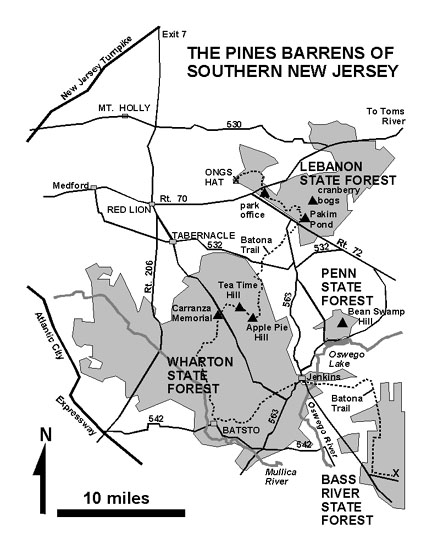The Pine Barrens of New Jersey
A trip to the pine barrens usually catches new comers by surprise. Driving through the seemingly endless forests of pitch pine can give you the impression that you are in some western state far away. This is even more intense when taking a long walk through the pine woods on one of perhaps hundreds of used and abandoned sand roads that penetrate the forests. Traveling south along the Garden State Parkway the transition from forests dominated by deciduous trees to pines occurs in southern Monmouth County in the vicinity of the Shark River, but it becomes quite obvious in the vicinity of Allaire State Park near the intersection with Interstate 195 (see Figure 133 on the Shark River page). However, the real remaining wilderness of the pine barrens is farther south in the south-central part of the state where several state forest preserves have been established for wilderness protection (Figure 135). The Batona Trail is a trail that winds almost 50 miles through the heart of the pinelands, linking three wilderness preserves in the region: Lebanon, Wharton, and Bass River State Forests . A fourth preserve, Penn State Forest, also offers excellent pinelands study and hiking opportunities.
 |
| Figure 135. Map showing parklands and features in the central Pine Barrens of southern New Jersey. |
The extent of the Pine Barrens of New Jersey roughly follows the outcrop belt of the Late Tertiary sedimentary rock formations (Kirkwood, Cohansey, and Beacon Hill Formations - see discussion on these formations on the Tertiary Stratigraphy page). It is the sandy composition of these formations that are responsible for the "piney" character of the land. Pines and several species of oaks thrive in sandy, acidic soil. The region received its name, "barrens," from early settlers who learned that the soil was completely unproductive for raising crops. As a result, the region has remained largely undeveloped except for generally short-lived industries that utilized the natural resources of the region: wood, iron ore, and sand. The name "pine barrens" applies to a vast region that extends from small patches in Monmouth County southward to Delaware Bay; the area is generally is limited to the tract between Garden State Parkway to the east and the New Jersey Turnpike to the west, an area of over 2,000 square miles. Actually, "pine barrens" are a common feature of the coastal plain from Florida to Maine. They develop in areas where the surface in underlain by well-drained sandy soil.
Like any forested region, pine barrens are adapted to occasional fires that periodically spread in a mosaic pattern across large areas. In the past, these fires were suppressed until it was learned that occasional fires added topsoil nutrient replenishment, they controlled insect infestation patterns, and aided in pine seed dispersal. It was also discovered that when fires were suppressed, dead-fall accumulated, and the fires that followed were both more intense and destructive. Now fires are allowed to burn in a more "supervised" manner. It isn't uncommon to see patches of smoke rising from different locations across the region.
Like most coastal ecosystems, the effects of regional development has essentially obliterated large portions of the original pine barrens in New Jersey, particularly in the north. Fortunately, great strides have been taken, by both the federal government and the state of New Jersey, to protect large portions of the remaining pine barrens. Today, the majority of this region is under the resource management authority of the New Jersey Pineland Commission (roughly a million acres). The value of the pine barrens in New Jersey was recognized by the United Nations when in 1983 it was designated an International Biosphere Preserve. In the past, the region has been threatened by a variety of development proposals and plans to utilized the water resources of the region. The greatest threat today, however, is perhaps the slow, steady encroachment of suburban-style development.
| Return to Geology of the Coastal Plain Province. |